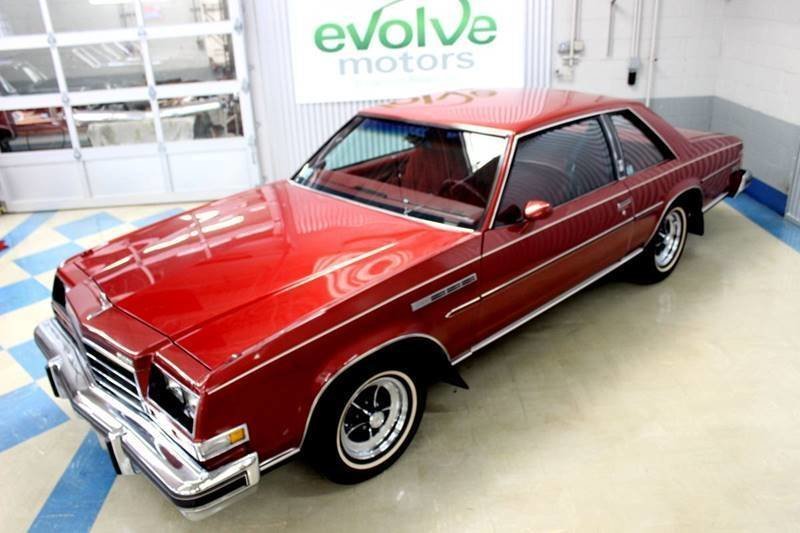Drivetrain
Chassis
Body

1979 Buick LeSabre
1979 Buick LeSabre
Sport Coupe
“Grand-Dad's Grand National
3.8L Turbo-Charged V6
3 Speed Automatic
ONLY 99,034 ORIGINAL
MILES
RARE
One Owner
-1 of Only 3,582 Built in 1979
True Survivor
Vin # 4F3739H548238
4
(Division) = Buick
F
(Series) = LeSabre Custom
37
(Body Type) = 2 Door Coupe
3
(Engine Type) = 231ci (3.8L) V6, Turbo
9
(Model Year) = 1979
H
(Assembly Plant) = Flint, MI
548238
(Sequential Serial Number
CALL TODAY 773-267-2684
WE SHIP WORLDWIDE
OFFERS WELCOME
Evolve Motors is pleased to present this wolf in sheep's clothing. It's part Regal. It's part Grand National. It's the 1979 Buick LeSabre Sport Coupe
When many enthusiasts think about turbo Buick power, they picture a Grand National, in basic black, all crisply folded sheet metal, and threatening attitude. Certainly, in later years, the GN got the lion's share of the attention from enthusiasts; with as much power available from six boosted cylinders as eight naturally aspirated ones, the turbo 3.8 has gone on to surpass mere cult status in the performance world, becoming a force to be reckoned with in its own right. A red Le Sabre is not what immediately springs to mind
But, once upon a time, the Buick 3.8L Turbo V-6 wasn't simply a kick-ass performance engine designed to boil the hides at the blip of a throttle and embarrass vehicles packing two more cylinders. It was a technologically complex answer to one of the most vexing problems of the OPEC-strangled Seventies: How do you achieve decent performance and good gas mileage, without radically altering the course of what an automobile should be
Buick had actually produced the answer in the early Sixties: One development of Buick's all-aluminum 215-ci. V-8, which eventually was sold to Rover of England and is still produced in modified form there today, was a 198-cubic-inch, six-cylinder version with a cast-iron block. It was America's first mass-produced V-6. Its uneven firing order produced a rough idle, which certainly wasn't very Buick-like. In 1963, displacement increased to 225 cubic inches. But in the go-go Sixties, demand for the upscale marque's little V-6, much less one that didn't idle smoothly, simply wasn't there. In 1967, Buick sold the design to Jeep, who then stopped production once AMC took ownership in 1970. Buick bought the rights and tooling back from Jeep in 1974, when the first gas crisis hit and AMC was in one of its perpetual financial crises. Buick furnished a 3.800-inch bore and a total displacement of 231 cubic inches, a displacement that remained unchanged through the Eighties; this was the same bore as Buick's own 350-cu.in. V-8, which allowed it to share pistons and other components and to be produced on the same assembly line. The odd firing order remained
Buick, known more as a luxury-car division than one with sporting intentions, later stated that their goal was to produce V-8 power with V-6 economy; reviving the muscle car appeared to be the last thing they had on their minds. Proof of this comes in the automobile you see here: the Buick Le Sabre Turbo Sport Coupe. Today, the Le Sabre seems an unlikely candidate for turbocharged power, but that is exactly what Buick did in 1978. The Le Sabre had gone through an Al Roker-style downsizing the previous year, losing ten inches in length and 650+ pounds, and came standard with a 301-cu.in. Pontiac V-8 in 1977; the turbo-powered V-6 became the standard Sport Coupe engine in 1978
I would like to cite Hemmings for an incredible description of an absolutely spectacular example of a late era "muscle car". I did revise a few points to fit this particular vehicle, but they hit the nail on the head in every which way, and this car is a shining example of what a true Sport Coupe is. Their information is invaluable and we appreciate what they do for the classic car market. (www.hemmings.com
Call Today For Full Write Up
1979 Buick LeSabre
Sport Coupe
“Grand-Dad's Grand National
3.8L Turbo-Charged V6
3 Speed Automatic
ONLY 99,034 ORIGINAL
MILES
RARE
One Owner
-1 of Only 3,582 Built in 1979
True Survivor
Vin # 4F3739H548238
4
(Division) = Buick
F
(Series) = LeSabre Custom
37
(Body Type) = 2 Door Coupe
3
(Engine Type) = 231ci (3.8L) V6, Turbo
9
(Model Year) = 1979
H
(Assembly Plant) = Flint, MI
548238
(Sequential Serial Number
CALL TODAY 773-267-2684
WE SHIP WORLDWIDE
OFFERS WELCOME
Evolve Motors is pleased to present this wolf in sheep's clothing. It's part Regal. It's part Grand National. It's the 1979 Buick LeSabre Sport Coupe
When many enthusiasts think about turbo Buick power, they picture a Grand National, in basic black, all crisply folded sheet metal, and threatening attitude. Certainly, in later years, the GN got the lion's share of the attention from enthusiasts; with as much power available from six boosted cylinders as eight naturally aspirated ones, the turbo 3.8 has gone on to surpass mere cult status in the performance world, becoming a force to be reckoned with in its own right. A red Le Sabre is not what immediately springs to mind
But, once upon a time, the Buick 3.8L Turbo V-6 wasn't simply a kick-ass performance engine designed to boil the hides at the blip of a throttle and embarrass vehicles packing two more cylinders. It was a technologically complex answer to one of the most vexing problems of the OPEC-strangled Seventies: How do you achieve decent performance and good gas mileage, without radically altering the course of what an automobile should be
Buick had actually produced the answer in the early Sixties: One development of Buick's all-aluminum 215-ci. V-8, which eventually was sold to Rover of England and is still produced in modified form there today, was a 198-cubic-inch, six-cylinder version with a cast-iron block. It was America's first mass-produced V-6. Its uneven firing order produced a rough idle, which certainly wasn't very Buick-like. In 1963, displacement increased to 225 cubic inches. But in the go-go Sixties, demand for the upscale marque's little V-6, much less one that didn't idle smoothly, simply wasn't there. In 1967, Buick sold the design to Jeep, who then stopped production once AMC took ownership in 1970. Buick bought the rights and tooling back from Jeep in 1974, when the first gas crisis hit and AMC was in one of its perpetual financial crises. Buick furnished a 3.800-inch bore and a total displacement of 231 cubic inches, a displacement that remained unchanged through the Eighties; this was the same bore as Buick's own 350-cu.in. V-8, which allowed it to share pistons and other components and to be produced on the same assembly line. The odd firing order remained
Buick, known more as a luxury-car division than one with sporting intentions, later stated that their goal was to produce V-8 power with V-6 economy; reviving the muscle car appeared to be the last thing they had on their minds. Proof of this comes in the automobile you see here: the Buick Le Sabre Turbo Sport Coupe. Today, the Le Sabre seems an unlikely candidate for turbocharged power, but that is exactly what Buick did in 1978. The Le Sabre had gone through an Al Roker-style downsizing the previous year, losing ten inches in length and 650+ pounds, and came standard with a 301-cu.in. Pontiac V-8 in 1977; the turbo-powered V-6 became the standard Sport Coupe engine in 1978
I would like to cite Hemmings for an incredible description of an absolutely spectacular example of a late era "muscle car". I did revise a few points to fit this particular vehicle, but they hit the nail on the head in every which way, and this car is a shining example of what a true Sport Coupe is. Their information is invaluable and we appreciate what they do for the classic car market. (www.hemmings.com
Call Today For Full Write Up













































































































